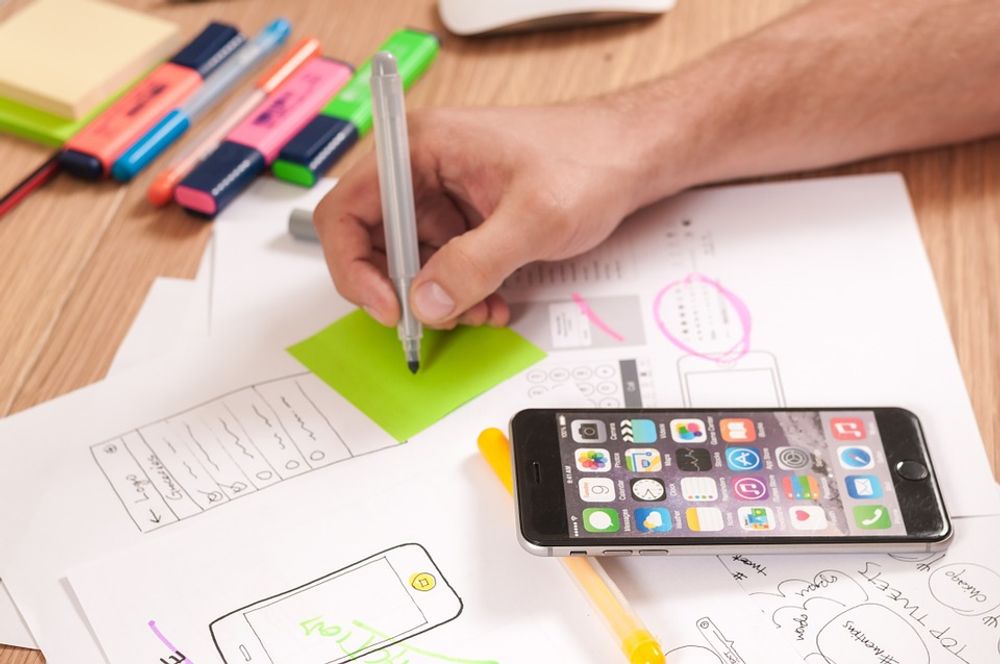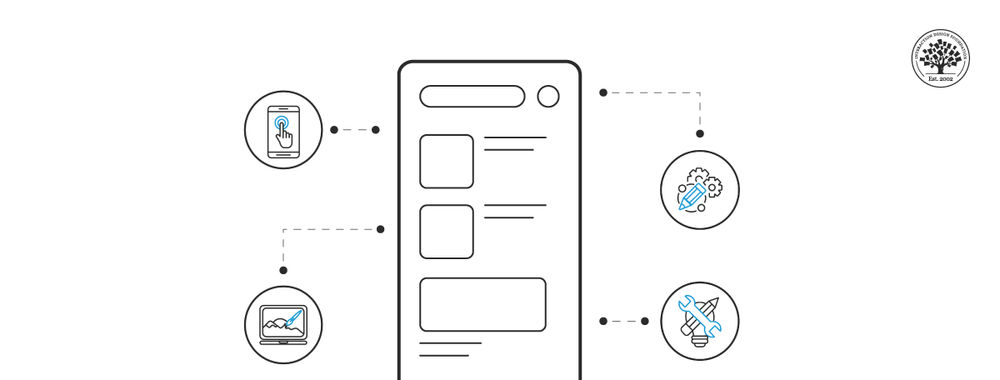“The main thing in our design is that we have to make things intuitively obvious,” the founder and former CEO of Apple, Steve Jobs, explained. We can easily agree that design should be intuitive. We can also easily agree that something is intuitive when we can use it without thinking about it. Making a design intuitive is much tougher. Solving this task requires an understanding of the psychology behind human interaction, specifically how humans come to understand the physical and cultural environment. In this article, you’ll learn the basic psychology behind designing intuitive user interfaces – and you’ll learn how to get started applying it.
The Connection between Intuition and Experience
Design does not become intuitive by magic. When we experience a design as intuitive, it's because we have encountered something like it before. In this article, we divide the users’ past experience into experience with the physical and cultural environment, and we explain how to take advantage of both types of experience to create intuitive interfaces.
“A technical system is, in the context of a certain task, intuitively usable while the particular user is able to interact effectively, not consciously using previous knowledge.” – Intuitive Use of User Interfaces (IUUI) research group. An interdisciplinary team of researchers who explore how to define intuitive use and interfaces.
From our very first breath, we interact with the physical environment and learn the fundamentals of how physical objects behave. We confront and learn from the physical reality every day. Humans also grow up in a cultural environment consisting of language, metaphors and symbols that are more localised and unstable than the physical environment. Some cultural artefacts we encounter all the time; some we only encounter occasionally.
Both the physical and cultural environment play a fundamental role in our expectations and understanding of the world. In a widely cited paper, psychologists and interaction design researchers Klaus Bærentsen and Johan Trettvik state that everything humans know how to do, we have learned at some point in our lives. Some things we learn as newborns; some things we learn as adults through hard study. When we first learn how to do something, it is a conscious action. With practice, actions turn into operations that we can perform without considering them. They are, in other words, intuitive.
All interface design builds on the users’ previous experience with the physical and cultural environment. When we design interfaces with objects that the user can move or sort into folders, the user can rely on her experience with the physical environment to understand the properties of the objects in the interface. When we use icons and text, the user relies on experience from the cultural environment to understand them. The user always uses both her experience from the physical and cultural environment to understand what action possibilities she has with an interface.
 Author/Copyright holder: Alexandre Duret-Lutz. Copyright terms and license: CC BY-SA 2.0
Author/Copyright holder: Alexandre Duret-Lutz. Copyright terms and license: CC BY-SA 2.0
When we design interfaces with objects that the user can move or sort into folders, the user can rely on her experience with the physical environment to understand the properties of the objects in the interface. Still, obviously, limitations to what we can do and how much information we can handle exist when we have to obey the laws of physics.
Bærentsen and Trettvik base their analysis on Activity Theory. Activity theory is a psychological theory which was pioneered by Lev Vygotsky, Alexei Leont'ev and Sergei Rubinstein and has been one of the leading theoretical frameworks for understanding human-computer interaction since the 1990s. According to activity theory, human cognition cannot be understood separately from the physical and cultural environment we grow up in, so it makes sense to analyse human technology interaction in this perspective.
Here, we follow the example of Bærentsen and Trettvik and use activity theory as a framework in which to understand intuition and experience with the physical and cultural environment. Let's start by taking a closer look at what characterises both types of experience and how we can take advantage of these in interface design.
The Cultural and Physical Environment Has Different Properties
When we design interfaces, we can build on experiences with the physical and cultural environment. The IUUI research group is an interdisciplinary team of researchers who explore how to define intuitive use and interfaces. In their model of intuitive use, they also include both experience from the cultural and physical environment, but argue that each has different properties. Users have more or less the same previous experiences with the physical environment everywhere in the world, but their experiences with the cultural environment differ. This means that an interface design can only be universally intuitive if it relies exclusively on experiences with the physical environment.
Looking back to activity theory, we see it's impossible to design such an interface because designs are cultural artefacts, used in a cultural context. At the same time icons, text, etc. have the advantage that the laws of physics do not bind the users’ expectations of them. Only the imagination sets limits to what we can do with cultural artefacts. Inspired by the IUUI research group, we can sum up the overall differences in terms of generalizability, practice, limits and changeability.
Experience with the physical environment | Experience with the cultural environment | |
Generalizability | The fundamental behaviour of objects is the same all over the world. All users share the same understanding of the physical world. | Culturally developed symbols and knowledge are localised and culturally specific. Users have different cultural backgrounds. |
Practice | We are constantly exposed to the physical environment, thus we do not forget how it works. | How much we are exposed to different cultural meanings and symbols varies. We tend to forget what we are not exposed to often. |
Limits | Design choices are limited by the laws of physics. New concepts cannot be introduced. | Technology, symbols and language have no inherent limitations. Our imagination is the only limitation. |
Changeability | The basic functionality of the physical world does not change. | Cultural meaning does not stay the same. |
Experience with the Physical Environment
When we use our fingers to manipulate interface objects directly on a touch display, we use skills that are based on experience with the physical environment. As infants we learn what we can expect when we move objects. They follow the tempo of our movements— and they do not suddenly disappear or move on their own. This is also how objects behave when we use direct manipulation in interfaces.
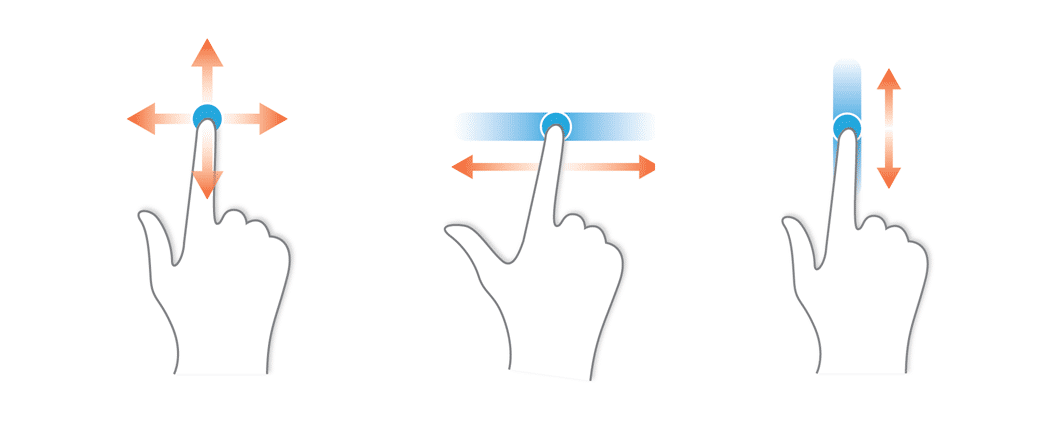 Author/Copyright holder: GRPH3B18. Copyright terms and license: CC BY-SA 3.0
Author/Copyright holder: GRPH3B18. Copyright terms and license: CC BY-SA 3.0
When we use our hands to manipulate objects directly on interfaces, we rely on our experience with how objects behave in the physical environment.
Our basic understanding of the physical environment has become a large research field in developmental psychology. Some researchers call this basic understanding “naïve physics”. Humans start experiencing and experimenting with the physical environment from infancy. The experience builds on the basic sensory-motor skills we learned the first time we held an object, the first time we dropped it to the floor, the first time we learned to crawl to our favourite toy, etc. Our experience with the physical world is so much a part of everyday life that astronauts on extended trips into space are probably the only people who do not take something such as gravity for granted, i.e., expect that objects fall down and stick to horizontal surfaces.

Author/Copyright holder: Pixabay. Copyright terms and license: Public Domain.
Our understanding of the physical environment builds on interaction with the world around us from a very early age.
Advantages of Experience from the Physical Environment
When we talk about intuitive or natural interfaces, we are often implicitly referring to interaction that is similar to our experience with the physical environment, and with good reason:
According to developmental psychology, we use our most basic cognitive skills when we interact with the physical environment. This means that we have large cognitive resources for interaction with interfaces that allow us to draw on experience from the physical environment.
Once we’ve learned the most basic skills as children, our learning curve is practically flat because interface objects and interactions simply behave the way we have come to expect from the world since infancy.
We do not forget how to perform interactions when we use skills from the physical environment even if we only rarely use the interface, because all of our other actions with objects, spaces, etc. in the physical environment act as a constant reminder that this is how the world works.
Interfaces that require skills learned from experience with the physical environment are accessible across different cultures, as our experiences with the physical environment are the same all over the world. The basic physical properties of the world do not differ between countries.
How We Use Experience with the Physical Environment in Interfaces
You can take advantage of the principles of naïve physics in a variety of different ways when you design interfaces:
Physics principle | Interaction principle |
Physical objects do not move on their own. | Users can move interface objects, which then remain where they are placed. |
Physical objects cannot be in two places at once. | When users move an interface object, it disappears from where it was. |
When we pick up physical objects and move them, they follow our hands. | When users move an interface object, it follows the tempo of the mouse or finger movement. |
If we let go of a physical object, it drops (gravity). | If the user releases the mouse button or lifts her finger, she also releases the interface object. |
We can place physical objects in a three-dimensional space. | In desktop-like interfaces the user can move and place objects in a three-dimensional space that looks two-dimensional. |
We move in a continuous line, so we can always retrace our steps. We cannot teleport from place to place. | If the user steps back in an interface, he will retrace his steps and end up in the exact place he started out. |
This is straightforward. So, why do we ever rely on any other type of experience when designing interfaces? The primary practical reason is that we cannot comfortably perform all aspects of interface interactions if we only rely on experiences from the physical environment. For instance, if you have a digital music collection of 30 million songs, you’re probably not interested in having to sort through them as you would sort through physical objects. Most of us would prefer another way of interacting even if we have to spend time and energy learning how to do it.
Luckily, activity theory argues that experiences from the cultural environment are also deeply embedded in human cognition, and although the cognitive limitations are different, experiences from the cultural environment can become intuitive over time.
Experience with the Cultural Environment
Can experience with the cultural environment turn into basic cognitive skills? If we use the IUUI research group’s definition of intuitive interaction, the answer is yes, but it is much more dependent on the individual user’s experience.
All humans grow up embedded in a cultural context. From a young age, we learn the meaning of language, metaphors and symbols. The play icon “►” is a good example of a symbol that people in many cultures learn at a young age. In any culture with access to media players, from iPhones and computers to DVD players and tape decks, people know the meaning of the ► icon. They encounter the icon so often that they expect a button with a ► icon to start playback in any media playback context. If we look back to activity theory, pressing a ► button was a focused activity that required conscious thinking at an early point in life, but most people cannot even remember at what point it turned into an automated operation. It is intuitive in nearly the same way that the behaviour of physical objects is intuitive. However, if you live in a culture without access to media controls, these icons have no inherent meaning.

Author/Copyright holder: Youtube. Copyright terms and license: Fair Use.
The play icon is a widely used symbol that has become intuitive to people who live in a culture that uses it.
Limitations of Experience with the Cultural Environment
Even though it's not what we normally refer to as intuitive, knowledge from the cultural environment can become intuitive with certain limitations:
We do not have the constant reminder from the physical world, which makes cultural experience easier to forget than experiences related to the physical environment.
We cannot be certain that users from all cultures know how to interact when the interaction is built on certain experiences from the cultural environment.
We might have to spend some effort learning new cultural knowledge if we are unfamiliar with the symbols used.
Cultural artefacts lie on a continuum from those widely distributed and well known (e.g., the play icon) to specialized knowledge only shared by a few. The main differences between the two ends of the continuum lie in how early in life we have learned something and how often we encounter it. Although neither has inherent meaning, something like the play icon that we have learned early in life and we encounter often is intuitive to a wider group of people than, e.g., “#”, the hashtag icon, signifying different topics on social media. This means that we cannot just analyse the inherent properties of a cultural artefact to understand how intuitive it is—we have to look at who our users are.
How We Use Experience from the Cultural Environment in Interfaces
One of the reasons we rely on experiences from the cultural environment in interface design is because too many restrictions arise if we only rely on experience from the physical environment. That is the case when we have to navigate 30 million songs, find information on the internet or use software solutions for complex systems. These types of interfaces provide users with opportunities and convenience that make it worthwhile spending some effort learning how to use them.
We use our experience with the cultural environment in interfaces when we encounter:
Metaphors (e.g., the desktop on your computer, which takes advantage of both our cultural experience of using desks at work and at home—and our physical experience of working by a desk)
Icons (e.g., ►or #)
Search (e.g., google)
Language (every time we encounter text)
Skeuomorphism (imitation of a well-known object from another domain, e.g., the trash can)
As you can see, many of the examples overlap with what we know from experience with the physical environment.
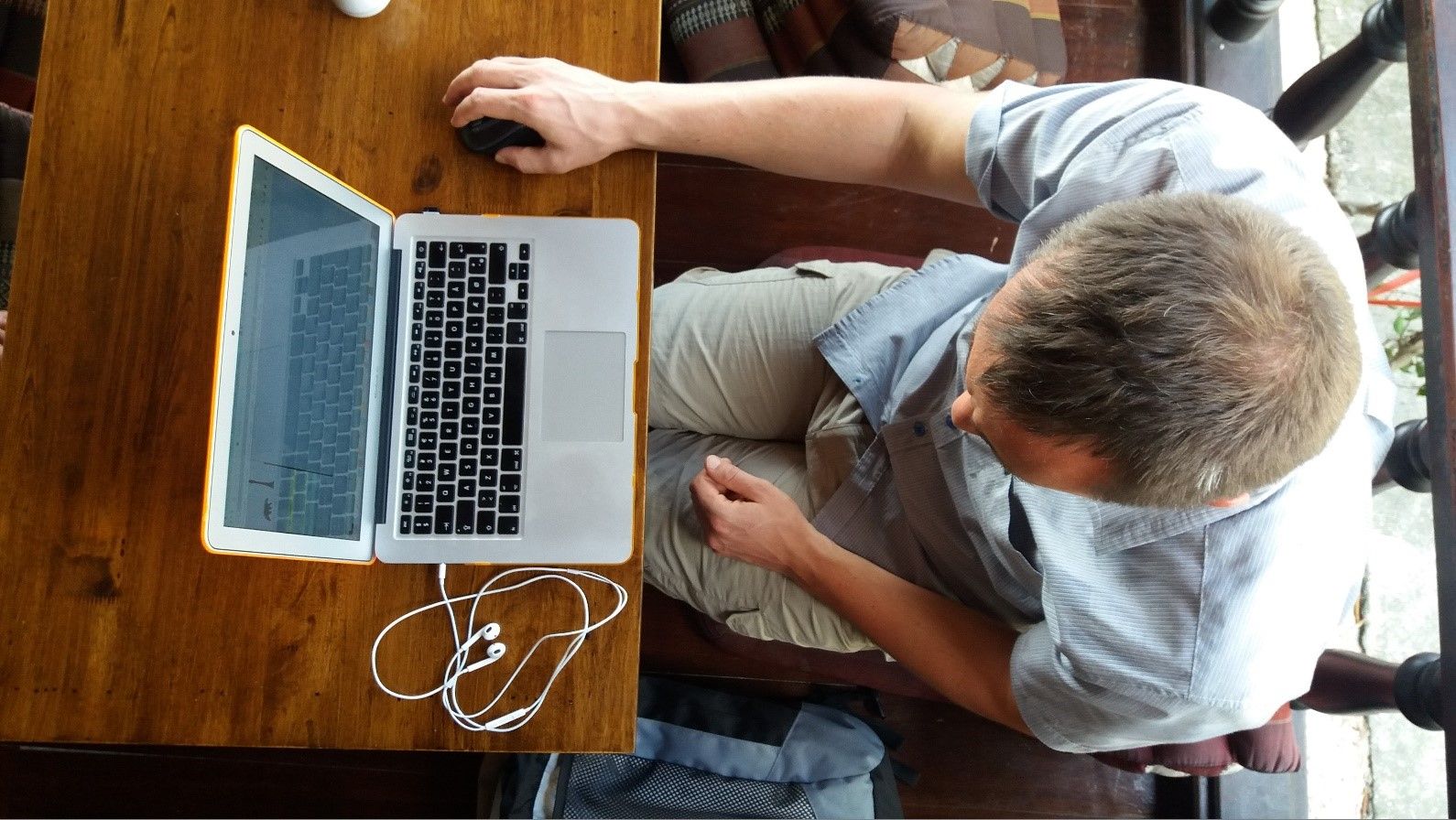 Author/Copyright holder: Rikke Friis Dam and the Interaction Design Foundation. Copyright terms and license: CC BY-NC-ND
Author/Copyright holder: Rikke Friis Dam and the Interaction Design Foundation. Copyright terms and license: CC BY-NC-ND
The desktop on your computer takes advantage of both your cultural experience of using desks at work and at home – and your physical experience of working by a desk.
Your Key Questions When You Want to Design for Intuition
“In my opinion, no single design is apt to be optimal for everyone.”
– Don Norman, Grand old man of User Experience
Here, we have made a clean division between experience with the physical and cultural environment, but the practicalities of interaction design are messier. An example is the interface trash can. Understanding the trash can symbol requires experience with physical objects that are able to contain other objects. However, it also requires experience with the cultural practice of designing objects designated to contain trash.
Two practical questions will help you in the messy reality of designing intuitive interfaces:
Who is my user and what is his/her previous experience with related products? If your particular user is used to doing interactions in a certain way, you should think very hard before breaking with her expectations. Even though a design does not appear as intuitive as it could be, experienced users may find it intuitive. If you have to accommodate different user groups who have different expectations for how something should work, a design that takes advantage of the user’s experience with the physical world will be easiest to learn and remember.
What is the current state of the art? If a state-of-the-art interaction for what you are designing already exists, you should consider how widespread it is. If it is commonly used (and not widely hated), consider following the same interaction principles as the current solutions. If several widely distributed solutions exist, try to choose the solution that relies the most on experience from the physical world.
If you are doing something new and groundbreaking, consider the balance between intuitive and convenient. As much as possible, try to include elements that draw on users’ experience with the physical environment, but do not limit users’ opportunities or convenience.
Inspiration to Help You Put Your Knowledge into Use
We want to help you create intuitive designs. To help you apply your knowledge, we’ve gathered a few analyses of how different designs take advantage of the two different kinds of experiences in their designs so you can use these as inspiration for your own designs.

Author/Copyright holder: Johnny Magnusson. Copyright terms and license: Public Domain.
Few things are more intuitive than this. From its shape, we know not to attempt to play a violin with it, even if pianos use (far softer) hammers to strike.
1.The Hammer
A hammer is the classic example of intuitive design. The weight and shape makes it very easy to learn the hammer’s graspability and functionality, taking advantage of our experience with the physical environment. At the same time, the hammer is a culturally developed artefact—and living in a culture with hammers and nails makes its use immediately obvious.
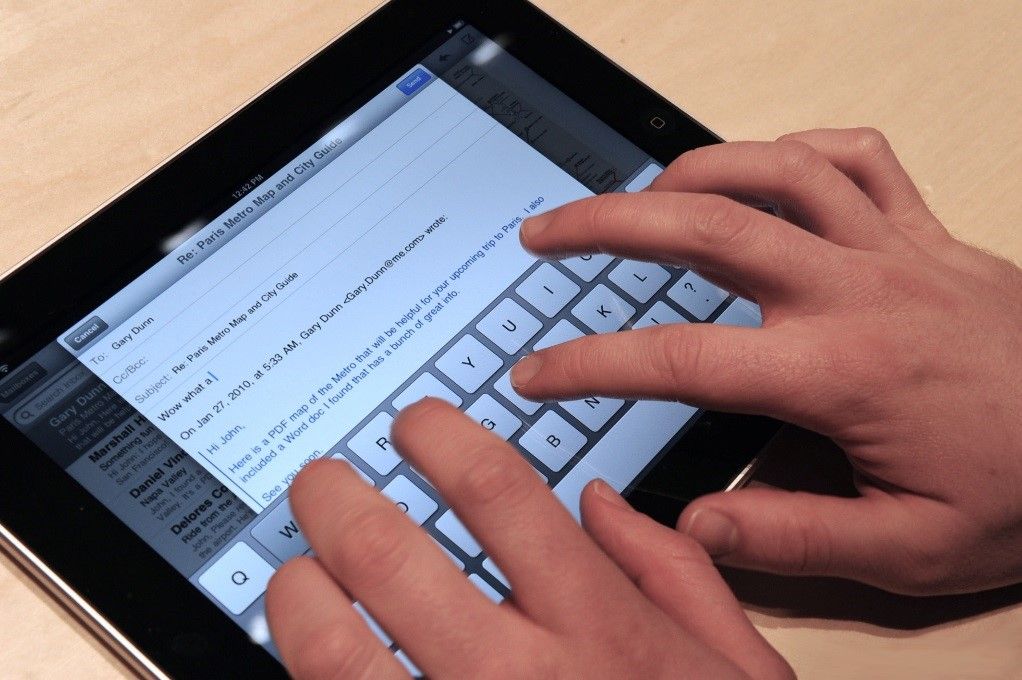 Author/Copyright holder: matt buchanan. Copyright terms and license: CC BY 2.0
Author/Copyright holder: matt buchanan. Copyright terms and license: CC BY 2.0
Dating back to 1872, the QWERTY keyboard has become an entrenched interface. Despite its non-optimal layout (efficiency wise), sheer familiarity with it enables touch-typing.
2.The QWERTY Keyboard
QWERTY is a keyboard layout for the Latin script. The name comes from reading the first six keys appearing on the top-left letter row of the keyboard (Q W E R T Y) from left to right. Virtual keyboards take advantage of the user’s experience with the physical environment in the sense that they imitate physical buttons, but the layout of the keys takes advantage of the user’s experience with QWERTY keyboards. The QWERTY keyboard has its roots in the physical limitations of the manual typewriter and the work of telegraph operators. It is not laid out in the way that would be most efficient for modern typing. Designers have tried to introduce more efficient layouts, but with limited success. Most of us can probably remember how long it takes to learn how to use the QWERTY keyboard efficiently, but once we have learned it, we can type without thinking about where the keys are located—so, it has become an intuitive operation. Using a different keyboard layout in your design will break the user’s expectations.
 Author/Copyright holder: m01229. Copyright terms and license: CC BY-SA 2.0
Author/Copyright holder: m01229. Copyright terms and license: CC BY-SA 2.0
The iPad nicely marries user experience from the physical and cultural environment.
3.The iPad
We used direct manipulation on touch interfaces as an example of an interface that takes advantage of the user’s experience with the physical environment. The iPad is an example of a product that does this excellently, but it is also an example of a product where the user has to use her experience with both the physical and cultural environment. For instance, the clock and map icons refer to objects we know from the physical environment; we can move them in the interface in a similar manner to how we can move physical objects. The symbols themselves, however, require cultural knowledge about the properties of clocks and maps and knowledge of how to use them.
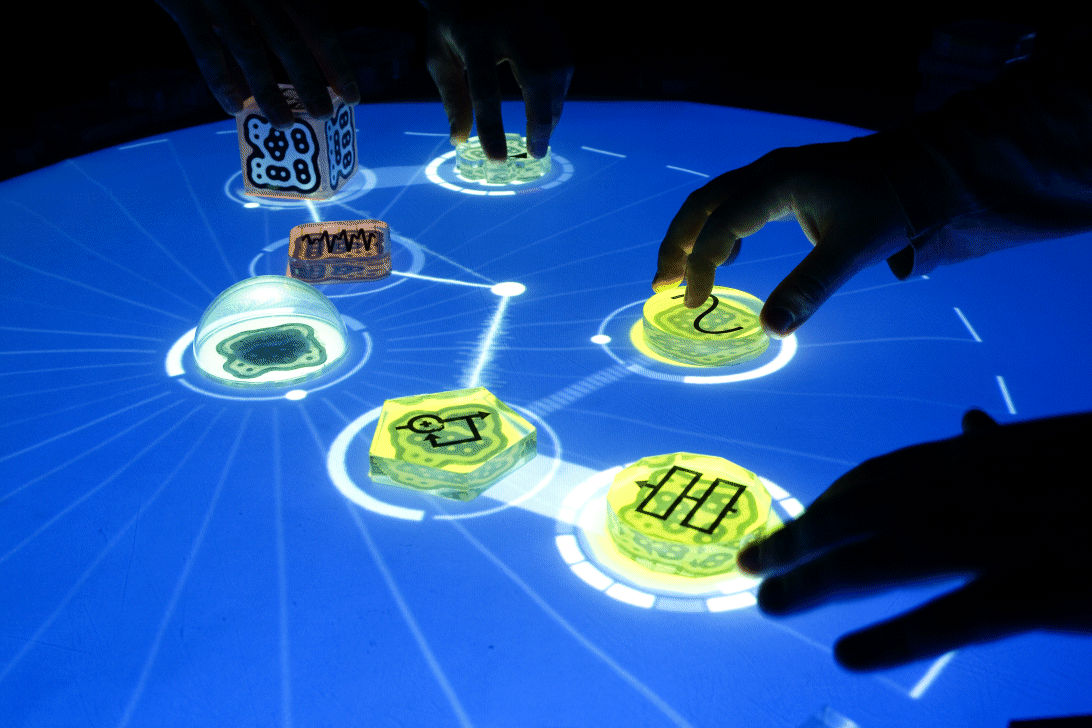 Author/Copyright holder: tweak Fäscht. Copyright terms and license: CC BY 2.0
Author/Copyright holder: tweak Fäscht. Copyright terms and license: CC BY 2.0
The reactable looks like a popular instrument for/from the year 2100.
4.The Reactable
The reactable is a digital music instrument that is a good example of a design in a new domain that takes advantage of the users’ experience with the physical environment, while still providing options outside the physical domain. It is a table with a digital interface controlled by physical objects. The physical objects allow users of all kinds to experiment with the interface, because they have experience with manipulating physical objects. The virtual surface and the symbols allow the user to learn more advanced options with the interaction, which may become intuitive over time.
The Take Away
Intuitive design is not simple to achieve. You must always base your designs on a good understanding of users’ prior experiences and the expectations they form based on these. You can use the activity theoretical framework and the research on intuitive use to identify how to take advantage of different types of prior experience to design more intuitive user experiences. Here, we divide the users’ experience into experience with the physical and cultural environment. You should take advantage of both types of experience to create intuitive interfaces. If creating something new and groundbreaking, you can make your design universally understandable by taking advantage of the user’s experience with the physical environment. If making something in a well-known domain, you should look at what other designs the user is likely to have experience with. In most cases, you will probably end up doing some of both, since people use all technology in an environment that is both physical and cultural.
References & Where to Learn More
Hero Image: Copyright holder: Rikke Friis Dam and the Interaction Design Foundation. Copyright license: CC BY-NC-ND
Anja Naumann et al. and the IUUI research group (2007) “Intuitive Use of User Interfaces: Defining a Vague Concept”. In Engineering Psychology and Cognitive Ergonomic. Volume 4562 of the series Lecture Notes in Computer Science, 128-136
Klaus Bærentsen & Johan Trettvik (2002). “An activity theory approach to affordance”. In O.W. Bertelsen, S. Bødker & K. Kuuti (Eds.) Proceedings of the second nordic conference on human-computer interaction, 51-60
To learn more about Activity Theory and how you can use it in interaction design, read the Interaction Design Foundation’s chapter on Activity Theory written by Victor Kaptelinin.
If you want to learn more about how humans learn about the physical world and naïve physics in interfaces, two good sources are:
Renée Baillargeon (2002) The Acquisition of Physical Knowledge in Infancy: A Summary in Eight Lessons. Chapter 3 of Blackwell Handbook of Cognitive Development (ed. U. Goswami), Blackwell Publishers Ltd.
Robert J.K. Jacob (2008) Reality-Based Interaction: A Framework for Post-WIMP Interfaces.CHI '08: Proceedings of the Twenty-Sixth Annual SIGCHI Conference on Human Factors in Computing Systems. Florence, Italy: ACM, 201–210




